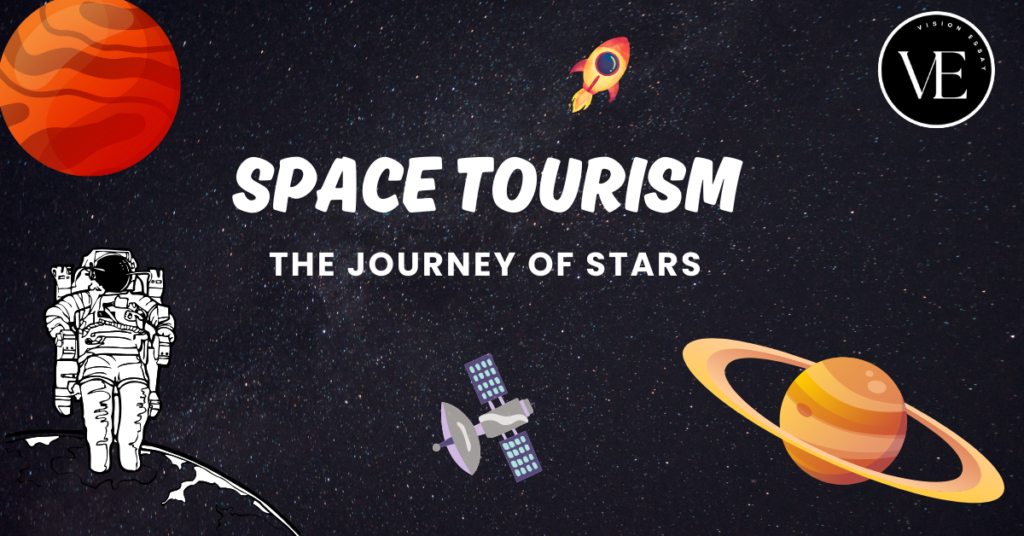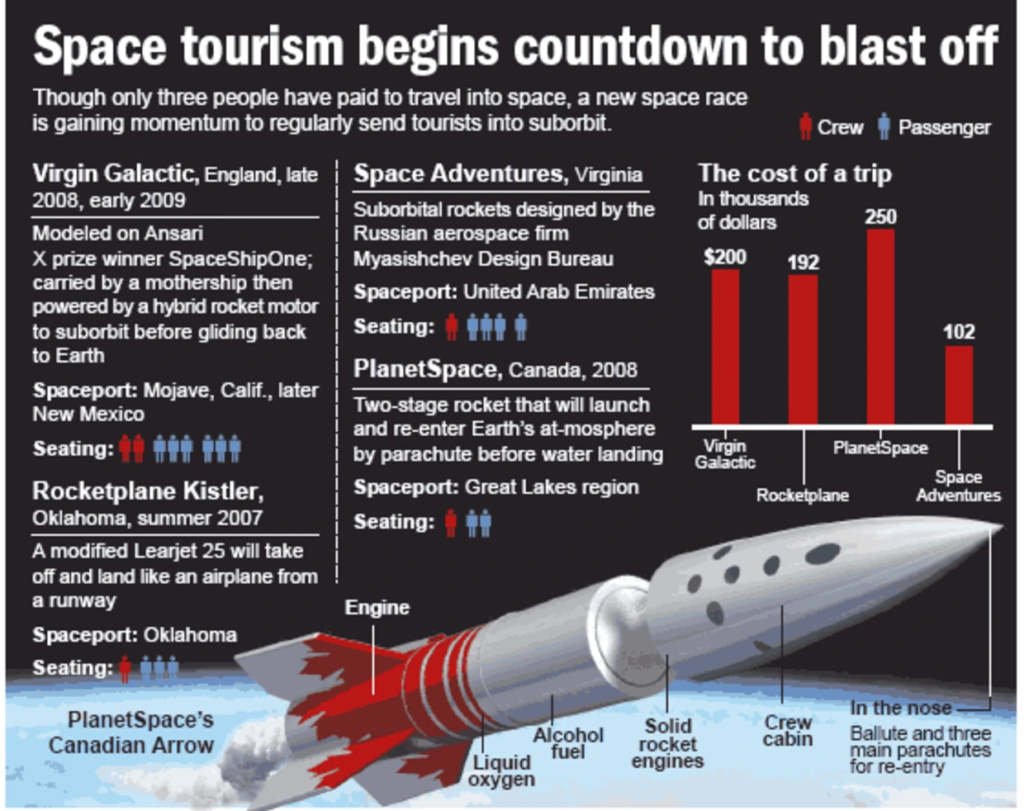
Introduction
The dawn of space tourism is transforming this dream into reality. Gopi Thotakura, an Indian-born commercial pilot living and working in the US, has made history as the country’s first space tourist. She had a quick, leisurely space flight with five other space travelers.
What is Space Tourism?
- When private persons are sent into space for pleasure, adventure, or amusement, this is referred to as space tourism.
- A small subset of the aviation sector called “space tourism” aims to provide travelers with the opportunity to go to space for pleasure, business, or both.
- After passing over the Karman line, which is generally acknowledged as the demarcation line dividing Earth’s atmosphere from space, space flight commences at a height of around 100 kilometers from the planet.
- Anything falling below this level is referred to as an airplane, while anything above it is referred to as a spacecraft.
What are the Types of Space Tourism?
- Suborbital Flights: Travelers on these journeys are sent to the edge of space, about 100 kilometers (62 miles) above Earth, where they may glimpse the planet’s curvature and experience a brief period of weightlessness before landing back on Earth. Renowned suborbital space travel firms include Virgin Galactic and Blue Origin.
- Orbital Flights: These entail ascending to a greater height, usually requiring many Earth circles. These excursions may last many days or just a few hours. Space travelers have traditionally visited the International Space Station (ISS). Organizations like as SpaceX and Axiom Space are attempting to increase the accessibility of orbital space tourism.
- Lunar and Beyond: It is planned to conduct space tourism missions that will circle the Moon and maybe beyond. Enterprises such as SpaceX, with its Starship spacecraft, have grand ambitions to ferry visitors to moon flybys.
How Does Space Tourism Work?
- Booking a Trip
- Choosing and Purchasing: Potential space travelers choose a space tourism company and buy a ticket. Depending on the kind of flight (orbital vs. suborbital), costs can range from hundreds of thousands to millions of dollars, therefore this frequently requires a significant financial commitment.
- Pre-Flight Preparation
- Medical Screening: To make sure visitors are suitable for space flight, they go through a thorough medical check. This aids in locating any health problems that the space environment can make worse.
- Programs for Training: Training sessions might range from a few days to several months. This instruction consists of:
- Physical Training: Workouts to increase stamina and get ready for the physical demands of spaceflight, such as G-forces during takeoff and landing.
- Safety procedures include training on spacesuit use, emergency procedures, and other safety precautions.
- Mission Simulation: To acquaint tourists with the experience, several flight stages are simulated.
- The Flight Experience
- Launch: The spaceship is launched to start the voyage. This might be a horizontal takeoff (spaceplane) or a vertical launch (rocket).
- Suborbital Flights: For businesses such as Blue Origin and Virgin Galactic, the vessel travels to the edge of space, around 100 km above Earth, where passengers may feel weightless for a brief period and observe the Earth’s curvature before heading back.
- Orbital Flights: The spacecraft reaches Earth’s orbit for longer trips, such the ones that SpaceX has planned. These trips may take several days or only a few hours.
- Activities in Space: Travelers may see Earth from orbit, feel what it’s like to be weightless, and take part in a variety of activities including scientific research or just relaxing in the unusual atmosphere. There may also be chances to visit space stations or other orbiting structures while in orbit.
- Launch: The spaceship is launched to start the voyage. This might be a horizontal takeoff (spaceplane) or a vertical launch (rocket).
- Re-Entry and Landing
- Re-Entry: The spacecraft makes a considerable temperature and G-force entry back into Earth’s atmosphere. The spacecraft’s architecture makes sure that it can endure these strains while safeguarding the occupants.
- Landing: Returning to Earth, the spaceship makes a landing. For spaceplanes, this can be a parachute-assisted landing in a pre-designated place, or a controlled descent with a runway landing (for capsules).
- Post-Flight Activities
- Medical Check-Up: Following landing, travelers go through medical examinations to make sure the flight did not have any negative consequences on their health.
- Debriefing and Experience Sharing: To share their insights and offer input to the space tourism operator, participants frequently participate in debriefing sessions. Additionally, they could get souvenirs or diplomas honoring their journey.
Also read: Effect of ChatGPT on Education in 2023
What is the Market Size of Space Tourism?
- Although the business is still in its infancy, it is expanding quickly in tandem with the rising demand for space travel, and between 2023 and 2030, it is projected to increase at a rate of 40.2% annually.
- The market for space tourism was estimated to be worth USD 695.1 million globally in 2022 and is expected to grow to USD 8,669.2 million by 2030.
- With 49.3% of the market share overall in 2022, the sub-orbital category led the market.
- On the other hand, throughout the projected period, the orbital section is anticipated to increase at the quickest rate of 41.0%.
What are Challenges to Space Tourism?
- High Costs
- Currently, space tourism is too expensive, with tickets for orbital trips costing tens of millions of dollars and suborbital flights costing hundreds of thousands of dollars. It is imperative to lower these expenses to increase the accessibility of space tourism.
- According to a recent NASA report, SpaceX and Space Adventures intended to charge between USD 70 and USD 100 million (about Rs 600 and 850 crore) for a lunar orbital trip.
- Safety
- Risk of Accidents: There are several intrinsic dangers associated with space flight, including the potential for launch failures, problems during re-entry, and radiation exposure. One of the main concerns is making sure that space tourists, who are not actual astronauts, are safe.
- Health Risks: Particularly during extended missions, it is important to minimize the negative consequences of microgravity on the human body, including as muscle atrophy, loss of bone density, and space sickness.
- Environmental Impact
- Space Debris: A developing issue that endangers both crewed and uncrewed spacecraft is space debris, which might be exacerbated by an increase in space tourism.
- Environmental Footprint: It is important to consider how rocket launches may affect the climate and release greenhouse gases, among other environmental effects.
- Technology
- Development and Reliability: It is a difficult and expensive task to create dependable spacecraft and technology that can carry travelers to and from space safely. Rigorous testing and ongoing innovation are necessary.
- Infrastructure: Constructing the required infrastructure, such as private space stations and spaceports, is essential but both financially and logistically difficult.
- Regulation and Legal Issues
- Regulatory Frameworks: To ensure safety, liability, and space traffic management, national and international legislation governing space tourism must be established.
- Liability and Insurance: It is difficult and requires extensive legal frameworks to determine who is responsible for accidents and to provide space travelers with sufficient insurance coverage.
What are the Opportunities for India in the Space Tourism Sector?
- Leveraging ISRO’s Expertise
- The Mars Orbiter Mission (MOM) was one of the successful space missions in which the ISRO has demonstrated its technological prowess. This gives hope for the next human spaceflight endeavors.
- Future space tourism may be more affordable as a result of ISRO’s economical space missions, making it more accessible to a larger group of people.
- Fostering a Thriving Public-Private Space Partnership
- The Indian government is pushing for private industry involvement in space exploration. Innovation is being fueled by policies that support it and initiatives like ISRO’s New Space India Limited (NSIL) that are drawing investments.
- For instance, PSLV-C53 is India’s first formal instance of a public-private space launcher partnership.
- SpaceX and Blue Origin are two examples of private companies showing that these alliances may work.
- Future Plans
- In addition, the ISRO is working on a reusable space tourism module that should be operational by 2030 and cost an estimated Rs 6 crore each trip.
What is the Future of Space Tourism?
- Accessible to Wealthy
- According to ISRO, affluent individuals could afford space tourism by 2030, with tickets typically costing around 6 crores. Soon, ISRO hopes to commercialize space travel in India.
- Beyond Earth’s Orbit
- We have only just begun to explore orbital and suborbital flight.
- Companies like Mangalyaan (India), Mariner 4 (NASA), ExoMars (ESA), Tianwen-1 (China), and Hope (UAE) are already focusing on lunar exploration and, eventually, deep space exploration.
- Space Staycations
- Companies are already creating modules for space passengers to reside in for extended periods, extending the idea of space tourism beyond quick visits.
- Focus on Sustainability
- Creating reusable rockets will probably receive increased attention to reduce space trash and improve the environmental impact of space travel.

Conclusion
Space tourism, exemplified by pioneers like Gopi Thotakura, transforms dreams into reality. Despite high costs and safety concerns, this burgeoning industry offers suborbital, orbital, and lunar experiences. With a projected annual growth rate of 40.2%, space tourism promises expansive opportunities, including India’s potential contributions via ISRO. The future of space travel holds promise for greater accessibility and sustainable innovations.
Frequently Asked Questions(FAQs)
How much does a space tourism trip cost?
Prices vary significantly, with suborbital flights costing around $250,000 and orbital missions reaching tens of millions.
What kind of training is required for space tourists?
Space tourists undergo extensive training, including simulations of spaceflight conditions, emergency procedures, and acclimatization to weightlessness.
Is space tourism safe?
While space tourism involves inherent risks, companies prioritize safety through rigorous protocols and continuous technological advancements.
What is the environmental impact of space tourism?
Space tourism has a notable environmental impact, particularly due to rocket emissions. Companies are working on sustainable practices to mitigate these effects.
Sources:
- https://timesofindia.indiatimes.com/education/learning-with-toi/explained-what-is-space-tourism-how-can-you-book-your-ticket-to-space/articleshow/103931851.cms
- https://www.forbes.com/sites/duncanmadden/2023/12/09/new-space-tourism-operator-zephalto-reaches-for-the-stars-in-2024/?sh=66f07b0e18c2
- https://www.nasa.gov/space-travel-technology/
- https://en.wikipedia.org/wiki/Space_exploration
- https://indianexpress.com/article/explained/explained-sci-tech/gopi-thotakura-space-travel-cost-9344679/
- https://www.hindustantimes.com/india/space-tourism-reaches-for-the-stars/story-ctvFPyXqKWYSYFTG1GQBQI.html
- https://economictimes.indiatimes.com/news/india/meet-indias-1st-space-tourist-gopi-thotakura/the-first-indian-space-tourist/slideshow/110365543.cms?from=mdr
- https://aerospace.org/article/brief-history-space-exploration
